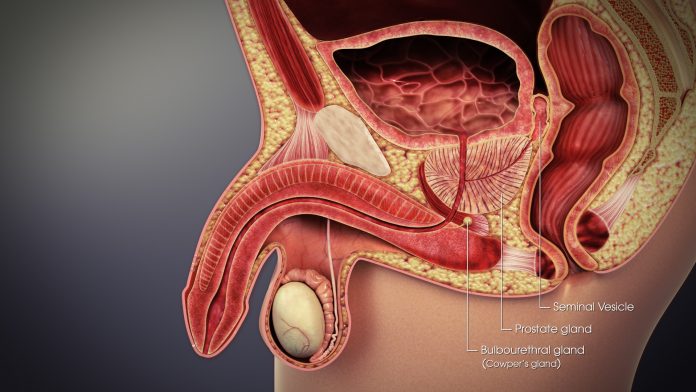What’s prostate cancer?
Prostate cancer is the most commonly diagnosed cancer in males worldwide. In the United States, the American Cancer Society (ACS) estimates that 268,490Trusted Source men will be newly diagnosed with this condition in 2022.
The prostate is a small gland found in a man’s lower abdomen, located under the bladder and surrounding the urethra. The hormone testosterone regulates the prostate. In addition, the prostate gland produces seminal fluid, also known as semen. Semen is the substance containing sperm that exits the urethra during ejaculation.
When an abnormal, malignant growth of cells — which is called a tumor — forms in the prostate, it’s called prostate cancer. This cancer can spread to other areas of the body. In these cases, because the cancer is made of cells from the prostate, it’s still called prostate cancer.
Types of prostate cancer
Almost all cases of prostate cancer are a type of cancer called adenocarcinoma that grows in the tissue of a gland, such as the prostate gland. However, other rare types of can also originate in the prostate, including:
small cell carcinoma, such as lung cancer
neuroendocrine tumors, such as pancreatic cancer
transitional cell carcinomas, such as kidney cancer
sarcomas, such as bone cell cancer
Prostate cancer is also categorized by how fast it grows. It has two types of growth:
aggressive, or fast-growing
nonaggressive, or slow-growing
With nonaggressive prostate cancer, the tumor grows slowly. However, with aggressive cancer, the tumor can overgrow and spread to other body areas, such as the bones, and becomes a metastatic cancer.
Prostate cancer causes and risk factors
There’s no known cause for prostate cancer, but risk factors such as family history or age may increase your likelihood of developing the malignancy.
Who’s at risk?
While prostate cancer could occur in any man, certain factors raise your risk for the disease. These risk factors include:
older age, 50 years of age or older
a family history of prostate cancer
certain ethnicities or race — for instance, African American males are at greater risk of having prostate cancer
obesity
genetic changes
Some studies consider other risk factors like diet and chemical exposure that may increase your diagnosis chances. However, the ACS says those effects are still unclear. Prostate cancer is also rare in men under the age of 40.
Prostate cancer symptoms
Some forms of prostate cancer are nonaggressive, so you may not have any symptoms. However, advanced prostate cancer often causes symptoms.
If you have any of the following signs or symptoms, don’t hesitate to call your doctor. In addition, other conditions can cause some symptoms of prostate cancer, such as benign prostatic hyperplasia (BPH), so you’ll need to check with your doctor to get a proper diagnosis.
Symptoms of prostate cancer can include urinary problems, sexual problems, and pain and numbness.
Urinary problems
Urinary problems are common because the prostate is located beneath the bladder and surrounds the urethra. Because of this location, if a tumor grows on the prostate, it could press on the bladder or urethra and cause problems.
Urinary problems can include:
frequent need to urinate
a stream that’s slower or weaker than normal
bleeding while urinating
Sexual problems
Erectile dysfunction may be a symptom of prostate cancer. Also called impotence, this condition makes you unable to get and keep an erection.
Blood in the semen after ejaculation can also be a symptom of prostate cancer.
Pain and numbness
You may experience weakness or numbness in the legs and feet. You may also lose control of your bladder and bowel if cancer has spread, causing pressure on your spinal cord.
Early detection of prostate cancer
One of the best ways to detect cancer before any symptoms appear is to undergo a screening test. The earlier you find cancer, the easier it may be to treat.
Prostate-specific antigen (PSA)
PSA is a blood test that measures the number of prostate proteins in your blood. If the level is high, it may indicate prostate cancer.
The PSA test is a useful tool for your doctor to consider whether or not your PSA levels may indicate prostate cancer. Since early detection is crucial for treating cancer, this is a major benefit. The test is relatively simple and widely available for people with a prostate that want to be screened.
However, there are pros and cons to screening. For example, a 2018 study found that PSA may increase your chances of early detection, but it doesn’t lessen your chances of dying from prostate cancer. The test has some associated concerns and it is important to discuss with your doctor what the risks of PSA screening would mean for you.
Other concerns to consider about PSA include:
accuracy level
over diagnosis and overtreatment tendencies
unclear overall benefit
Other factors can increase your PSA level, such as:
enlarged prostate
older age
ejaculation
prostate infection or inflammation
specific medications
Digital rectal exam (DRE)
When you undergo a DRE, the doctor places their lubricated, gloved finger into your rectum to feel any bumps, rigid, or enlarged areas of the prostate.
Since prostate cancer often starts at the back of the gland, it may be detected using this method. Although not as effective as a PSA test, it is more effective among men who have an average PSA level but still have prostate cancer.
Prostate imaging
Using advanced imaging, such as MRI or ultrasound, you can detect prostate cancer. In a 2018 research article, experts indicated that you can now catch it earlier — and better identify its stage — with improved technologies.
Prostate biopsy
Sometimes, your doctor may recommend a prostate biopsy if they suspect cancer from an exam or find that you have an elevated PSA level.
During the biopsy, the doctor takes a small sample of your prostate tissue to analyze the cells. If they find the cells are cancerous, it can also help them determine how quickly they may spread and grow. To do this, they determine your Gleason score.
The Gleason score is an effective tool to predict your outlook, but it isn’t absolute. There are many other factors involved when predicting the spread and course of the disease, with experts varying in how they use the scoring system.
To be sure, the best way to determine your outlook depends on other predictors in addition to your Gleason scores, like your physical exam and tumor imaging
Prostate cancer screening by age
The ACS does have screening recommendations for men as they get older.
First, they recommend that doctors talk to men about the pros and cons of screening prostate cancer during an annual exam. These conversations should occur for the following ages:
Age 40: For men at very high risk, such as those with more than one first-degree relative — a father, brother, or son — who had prostate cancer at an age younger than 65.
Age 45: For men at high risk, such as African American men and men with a first-degree relative diagnosed at an age younger than 65.
Age 50: For men at average risk of prostate cancer, and who are expected to live at least 10 more years.
Before you decide to undergo screening, consider all the information available, including uncertainties, risks, and benefits of prostate cancer screening. Then, you and your doctor can decide which test is best for you, if any.
Prostate cancer stages
Your doctor can discuss how far cancer has spread by using a staging system.
The American Joint Committee on Cancer (AJCC) TMN staging system stages prostate cancer. Like many other types of cancer, the system stages it by:
the size or extent of the tumor
lymph node involvement
whether or not cancer has spread (metastasized) to other sites or organs
PSA level at the time of diagnosis
Gleason score
Prostate cancer stages range from 1 to 4. However, the disease is most advanced in stage .
Prostate cancer treatment
Your doctor will develop an appropriate treatment plan for your cancer based on your age, health status, and the stage of your cancer.
Nonaggressive
If the cancer is nonaggressive, your doctor may recommend watchful waiting, also called active surveillance. This means you’ll delay treatment but have regular checkups with your doctor to monitor cancer.
If your doctor chooses to monitor cancer using active surveillance, they check your PSA every 6 months and perform an annual DRE. In addition, they may do a repeat biopsy and imaging in 1 to 3 years after initial diagnosis.
The doctor actively monitors your symptoms alone to decide if treatment is needed when simply observing the disease.
Aggressive
Doctors may treat more aggressive types of cancer with other options, such as:
surgery
radiation
cryotherapy
hormone therapy
chemotherapy
stereotactic radiosurgery
immunotherapy
If your cancer is very aggressive and has metastasized, there’s a good chance it has spread to your bones. For bone metastases, the above treatments may be used, in addition to others.
Prostatectomy
A prostatectomy is a surgical procedure removing part or all of your prostate gland. For example, if you have prostate cancer that hasn’t spread outside of the prostate, your doctor may suggest that you have a radical prostatectomy, which removes the entire prostate.
There are different types of radical prostatectomies. Some are open, which means you’ll have a larger incision in your lower abdomen. Others are laparoscopic, which means you’ll have several smaller incisions in your stomach.





























